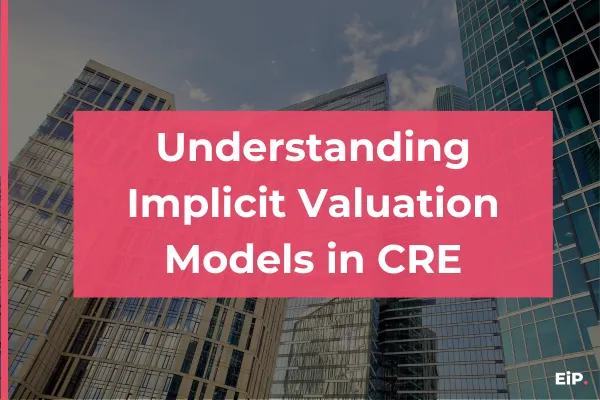
Understanding Implicit Valuation Models in Commercial Real Estate
Understanding Implicit Valuation Models in Commercial Real Estate
Implicit valuation models are at the core of how property professionals translate income into value. They underpin nearly every investment appraisal – from retail units to logistics assets – helping valuers and investors connect rental performance, yield expectations and capital pricing.
In this article, part of the EIP Academy’s Complete Guide to Property Valuation course, we explore three essential implicit valuation techniques: Income Capitalisation, YP (Years’ Purchase) Perpetuity / Multiplier, and Term & Reversion. Each video below walks through a worked example in Excel, showing how these models apply to real-world commercial property valuations.
1. Income Capitalisation Model
The income capitalisation model (also known as profit capitalisation) is one of the most widely used valuation methods in commercial real estate. It determines value by capitalising the property’s passing rent at a market-derived yield.
Example:
Passing rent – £40,000 per annum
Net initial yield (NIY) – 7%
Purchaser’s costs – 6.8%
The valuation formula is straightforward:
Value = Rent ÷ Yield
This gives the gross value (including purchaser’s costs). To derive the net market value, divide by (1 + purchaser’s costs). After rounding, the market value is approximately £540,000.
This approach is most appropriate for rack-rented properties, where the passing rent equals market rent – meaning the property is already at its full rental potential.
2. YP Perpetuity / Multiplier Model
The YP perp (Years’ Purchase in Perpetuity) or multiplier approach produces the same outcome as income capitalisation but frames it differently. Rather than dividing rent by yield, it converts the yield into a multiplier:
1 ÷ Yield = YP in Perpetuity
At a 7% yield, the multiplier is 14.29. Multiplying this by the market rent (£40,000) produces a gross value of roughly £571,000 – and around £540,000 after deducting purchaser’s costs.
This method is often used for revenue-generating assets such as hotels or care homes, where industry practice prefers multipliers to yields. Both models express the same relationship between income and value – just in different formats.
3. Term & Reversion Model
The term and reversion model is used when the property’s market rent is higher than the current passing rent – a reversionary scenario. It separates the valuation into two stages: the term (current income) and the reversion (future income).
Example:
Passing rent – £40,000 for 3 years
Market rent – £45,000 thereafter
Yield – 7%
Value the term – apply the YP formula for three years:
(1 − (1 + r)^–n) ÷ r
Value the reversion – capitalise the market rent in perpetuity, then discount (present-value) it back three years using:
PV = 1 ÷ (1 + r)^n
Combining these gives a total market value of around £590,000 – higher than the rack-rented examples because the rent will rebase to a higher market level in future.
This model captures the time value of income growth, allowing investors to reflect both immediate and future earning potential.
Why Implicit Valuation Models Matter
Implicit valuation models are central to commercial property valuation because they link three critical variables: income, yield and capital value.
For investors, they show how small shifts in rent or yield can significantly affect pricing.
For valuers, they enable consistent, market-based appraisals.
For students, they build the foundations for understanding cash flows, risk and pricing in real estate markets.
Understanding these models also prepares analysts for more advanced valuation approaches – particularly explicit models and discounted cash flow (DCF) analysis, which project individual cash flows rather than relying on aggregate yields.
Continue Learning with EIP Academy
These videos are part of the EIP Academy’s Complete Guide to Property Valuation course, designed for aspiring and practising property professionals who want to strengthen their analytical and Excel skills.
Alongside the Implicit Valuation Models series, the Academy also offers:
Explicit valuation models – focusing on detailed cash-flow projection and timing.
Advanced Discounted Cash Flows for investment analysis – applying DCF techniques to complex investment and development scenarios.
Join the EIP Academy today to gain practical, hands-on experience in valuation modelling and investment analysis – and turn theory into applied expertise.